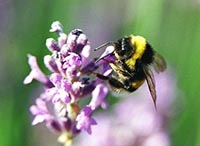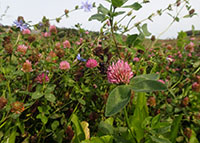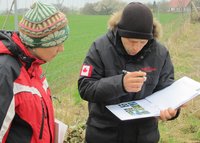Beefarm: Meeting the complex challenges of food and lodging to wild bees
During the first season the project Beefarm has found a total of more than 40 species of solitary bees in fruit farms with varying abundance and diversity in the individual farms. In the case of clover seed farms the project directs attention to the distribution between good and less efficient clover pollinators among the bumblebees.

From the wild bees’ perspective, Danish farmland is an unfriendly environment. 65% of the land area is farmed and around 85% of farmland is in rotation, offering a highly disturbed environment to some of its inhabitants.
Wild bees – bumblebees and solitary bees - are under pressure in Denmark and the rest of Europe. This threatens not only pollination of wild plant species, but also the yield of agricultural crops.
Especially fruit, berries and seed crops depend on wild bees and honey bees, but also oilseed rape and protein crops benefit from bee pollination.
Farmers are the main decision makers, and many farmers are motivated to improve conditions for wild bees. In addition to the production benefits of pollination they see protection and enhancement of biodiversity as a special responsibility.
Tool helps farmers to think like wild bees
In the project BeeFarm, researchers and 18 fruit growers and seed producers try to develop a simple tool to assist farmers in improving living conditions for wild bees.
Wild bees need “food and lodging”. The challenge is that we have more than 250 species of wild bees with different resource demands and varying ability to move around in the landscape to find these resources. Therefore the development of the tool is an exercise in making complex knowledge operational. The researchers want to help the farmers to “think like wild bees”.
The tool includes several steps:
- First step is the ”desktop planning” of a route for a walk on the farm land: A route passing all habitats which can be expected to offer food and nesting resources within a 500 m distance from the apple plantation or clover seed field. The identification of these habitats is based on publicly available land use and nature protection data. The project envisions that this task may be a future service provided by the advisory service.
- As step 2 farmers walk the route three times during the year: Spring, summer and late summer. Assisted by photo sheets with plants farmers evaluate each habitat (e.g. a hedge or a meadow) for the amount of bee food resources (flowers). Density measures are rough and they do not perform a botanical analysis. A new set of assessment sheets are provided for each of the three walks. Researchers walk the same route and assess in more detail.
The success criteria for this part of the assessment tool is that farmer and experts find approximately the same resources, and the results from the first year are promising. However the researchers are conscious of the challenge of finding the balance between data precision and manageability for farmers: How quick and simple is acceptable?
The next challenge, after getting a picture of the resources on the farm, is to analyse whether more resources actually result in more wild bees on the farm. The project traps wild bees three times during the season and do observations in the apples and clover seed. Analysis of the local landscape (500 m radius) but also the larger landscape is included, because this may influence especially the mobile bumblebees.
Observation of flower resources and bees with cameras
The project is still processing the data in order to find out whether such a rough assessment of resources can be linked in a meaningful way to the bees observed.
In spite of the work load connected with walking the route, all farmers with relevant crops continue in 2016 with the adjusted tool. Realizing that farmers are busy and may not be keen to register on paper, the project has conducted a small test by using a camera to assess flower resources while walking, and it is also tested whether cameras can be used for observations of the bees’ visits in apple flowers.
The project is coordinated by ICROFS and part of The Organic Research, Development and Demonstration Programme Organic RDD 2, supported by GUDP under The Danish Ministry of Environment and Food.
Read more about the project
Visit Beefarm's project website


